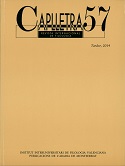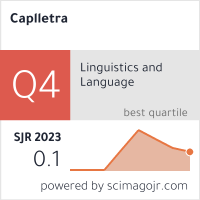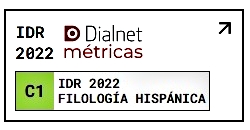The Catalan language in the Valencian edition of the «Regulae» of Masparrautha (1498)
DOI:
https://doi.org/10.7203/caplletra.57.6791Keywords:
llengua catalana, història de la llengua, dialectologia, valencià, aragonès Abstract
Abstract
Abstract: During the Middle Ages, Latin was taught for beginners in the Romance language in Spain, as well as in other European regions. A number of explanations in the vernacular were incorporated into Latin texts. An example of this tradition is the so-called grammaticae proverbiandi. They are characterized by a proverbium or sentence in the vernacular, which helps to understand the Latin structure better. This is the case of the Regulae by Esteban de Masparrautha, printed in 1492 in Pamplona, with examples in Navarrese-Aragonese, as well as in 1498 in Valencia, with examples in Catalan. Emma Falque (2011) has recently published an edition of the incunabulum of Pamplona, which includes an appendix showing the proverbia in Catalan.
In this paper, the characteristic dialectal features of Western Catalan — more specifically, from the Southern area — will be determined by linguistic analysis of the abovementioned examples. Features that do not have any dialectal connotation, as they were generally common in medieval texts regardless of their origin, will be also discussed. Some of these latter features still show in certain subdialects, while others have disappeared.
Key words: Catalan language, history of language, dialectology, Valencian, Aragonese.
 Downloads
Downloads
Downloads
Published
How to Cite
-
Abstract302
-
PDF (Català/Valencià)185
Issue
Section
License
Authors submitting work to Caplletra for publication must be the legitimate holder of the usage rights. Legitimacy for the purposes of publishing the work must also include images, tables, diagrams and any other materials that may complement the text, whether they are the author of such material or not.
Copyright: on publishing their work in the journal, the author grants Caplletra. Revista Internacional de Filologia usage rights (reproduction, distribution and public communication) for both the paper printed version and for the electronic version.
All work published in Caplletra is covered by the Creative Commons license type Attribution-NonCommercial-NoDerivatives 4.0 (CC BY-NC-ND 4.0).
RESPONSABILITY
Caplletra. Revista Internacional de Filologia does not necessarily identify with the points of view expressed in the papers it publishes.
Caplletra. Revista Internacional de Filologia accepts no responsibility whatsoever for any eventual infringement of intellectual property rights on the part of authors.







